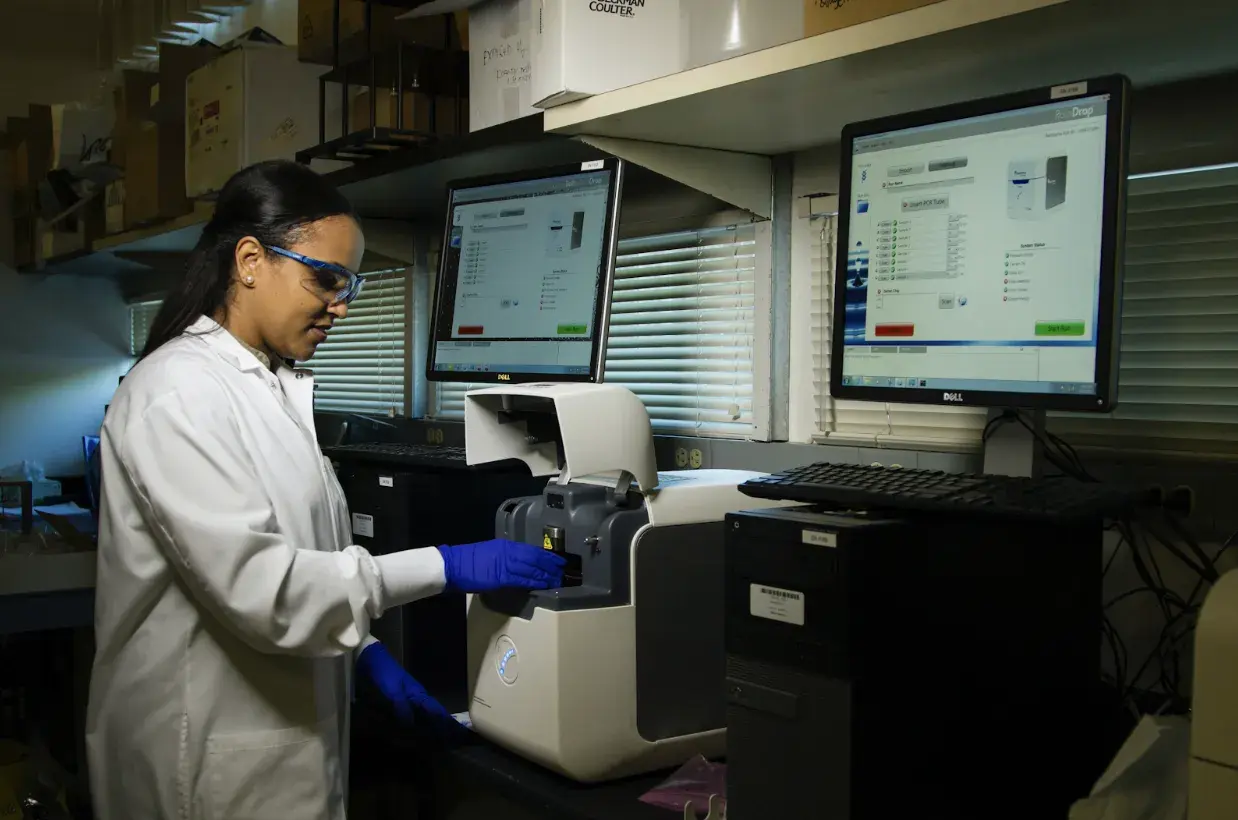What is High Throughput Sequencing?
The use of high throughput sequencing in metagenomics is becoming increasingly important as researchers strive to study the interactions...

RNA sequencing is a powerful tool for studying gene expression, genetic variation, and the regulation of gene expression. It can also be used to study the structure of RNA molecules and their interactions with proteins, amongst a number of other applications across a variety of research fields.
In this guide, we will explore the various types of RNA sequencing applications that can be used, as well as provide a brief guide on what RNA sequencing is and its core advantages. By the end of this guide, you should have a better understanding of how RNA sequencing can be used to advance your research efforts.
RNA sequencing (RNA-Seq) is a sequencing technique that uses the capabilities of high-throughput sequencing methods to reveal the presence and quantity of RNA in a biological sample, providing insights into the transcriptome of a cell.
RNA-Seq data analysis combines experimental biology, computational biology and systems biology to create an analysis pipeline that offers high-quality, detailed biological insights. This makes it a powerful tool for studying differential gene expression analysis, genetic variation, and other aspects of gene regulation and gene fusions.
RNA-Seq analysis is also commonly used to study the structure of RNA molecules and their interactions with proteins, making it an important tool for researchers in many different fields.
There are a number of different RNA sequencing methods available, including:
Which RNA-Seq analysis method is best for you will depend on a number of factors, such as your target RNA population, the sample type, and your experimental goals. However, with so many options available, there is sure to be a method that fits your needs.

Key advantages of RNA-Seq include:

RNA-Seq can be applied to taxonomic profiling of transcriptomes, allowing researchers to gain a better understanding of the diversity and prevalence of different gene transcripts in different species.
Taxonomic profiling is prevalent in environmental microbiology, where scientists are using RNA-Seq to help assess the diversity and abundance of bacteria in different ecosystems, leading to additional applications in biodiversity and biogeography.
RNA-Seq can be used to perform functional profiling of RNA transcripts, allowing researchers to gain a better understanding of the function and regulation of different genes.
Functional profiling is useful for studying gene expression in diseases and disorders, as well as for studying cellular pathways and networks. RNA-Seq has been particularly effective in these applications, allowing scientists to identify differentially expressed transcripts and gain deeper insight into the molecular mechanisms underlying many diseases.
RNA-Seq can be used to perform gene expression profiling, allowing researchers to gain a better understanding of which genes are actively producing proteins at any given time. This information is important for studying cellular processes and functions, as well as for assessing the effects of various environmental or medical stimuli on gene activity.
For example, regional protein expression in the human Alzheimer’s brain correlates with disease severity, according to Xu J. et al. (2019).
Using RNA-Seq to profile gene expression, they found that several genes showed significant variations in the levels of protein production between patients with different disease severity levels. These results suggest that RNA-Seq may be a useful tool for assessing disease progression and prognosis.
This process tells us which genes are actively producing proteins at the moment of meta-transcriptomic sequencing.
Differential expressions in genes are a key feature of RNA sequencing data analysis, and researchers can use this information to identify differentially expressed genes associated with specific diseases or disorders.
Differential expression analysis is widely used in clinical research and drug development, as well as for studying the molecular mechanisms underlying many biological processes.
By identifying differentially expressed genes using RNA-Seq experiments, researchers can gain a better understanding of the genes and pathways involved in disease progression, as well as identify potential drug targets for therapeutic intervention.
Single cell sequencing can also be used to perform RNA sequencing of individual cells, allowing researchers and clinicians to gain a better understanding of the molecular mechanisms underlying cellular heterogeneity.
Single cell sequencing has many medical applications, including in cancer research and developmental biology. By performing single-cell RNA molecule sequencing on different types of cells in an organism, scientists can gain valuable insights into the diverse functions of different cell types, as well as learn more about how these cells interact and communicate with each other.
This information can ultimately lead to new insights into cellular processes and disease mechanisms.
Transcriptome analysis via RNA-Seq can also be used to perform medical exome panel analysis, helping clinicians and researchers identify the genetic variants associated with different health conditions or disorders.
Medical exome panels are an important tool for personalizing medicine and improving disease treatment outcomes. By studying the transcript variation associated with different diseases and conditions, scientists and clinicians can develop targeted treatments that are more effective for individual patients.
RNA-Seq can also be used to identify and study different types of regulatory elements, including silencer and enhancer regions.
Silencer and enhancer regions are important for regulating gene expression in different cells or tissues, and studying these regions can provide valuable insight into the complex mechanisms underlying many biological processes. By identifying different types of regulatory regions using RNA-Seq, researchers can gain a better understanding of how gene expression is controlled and modulated in different cell types.
Small RNAs are another key feature of RNA-Seq data, and researchers can use this information to identify differentially expressed microRNAs (miRNAs) or other small non-coding regulatory RNAs.
MicroRNAs and other small RNAs play important roles in regulating gene expression and controlling cell differentiation, proliferation, and other important cellular processes.
By profiling small RNAs using RNA-Seq, researchers can gain a better understanding of how these small regulatory molecules impact different biological pathways and disease mechanisms.
RNA-Seq can also be used to identify genetic variants, including single nucleotide polymorphisms (SNPs) and copy number variations (CNVs). By identifying nucleic acids in clinical samples, scientists can study gene expression at the allele level and gain valuable insights into how genetic variations impact gene expression, predisposition to disease, and other important factors.
In addition, RNA-Seq can be used to study allele-specific expression, which is the differential expression of alleles at a given gene locus. This information can be used to gain a better understanding of the molecular mechanisms underlying genetic inheritance and disease susceptibility.
Alternative splicing is a process by which a single gene can produce multiple mRNA transcripts and proteins, allowing for a wide range of gene expression patterns.
By studying alternative splicing patterns using RNA-Seq, researchers can gain valuable insights into the roles of different genes in different cellular processes and better understand how genetic variation might influence disease progression or response to treatment.
Finally, RNA-Seq can be used to generate and study large-scale systems biology datasets. By integrating different types of biological data, including gene expression profiles and genetic variation information, scientists can gain a more holistic understanding of complex biological processes and disease mechanisms.
At Cmbio, our RNA and metatranscriptomics sequencing services are designed to help scientists and clinicians better understand genetic variation, disease mechanisms, and other important factors.
We offer a range of RNA-Seq services, including exome panels, small RNA profiling, alternative splicing studies, and systems biology research.
We also provide a number of genome sequencing, DNA sequencing and next generation sequencing services for researchers at all levels, from academic and clinical institutions to biotechnology and pharmaceutical companies.


The use of high throughput sequencing in metagenomics is becoming increasingly important as researchers strive to study the interactions...

The skin is the largest organ of the human body, serving as a crucial barrier between our internal systems and the external environment. The human...

4 min read
Even after the height of the pandemic, there is still an ongoing battle against the global coronavirus disease, meaning the realm of metagenomics...